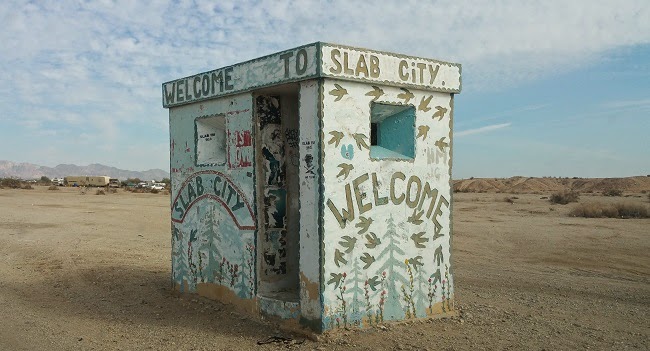Dayana
Slab City, CA
A Brief History
Slab city is a community that has a population that ranges from 100-2,500 people depending on the time of year located in the Sonoran Desert in Sunny Southern California. The population fluctuates throughout the year due to their inhabitants being snowbirds, people who migrate to cooler climates depending on the time of year. During the summer, a majority of the residents travel up north to escape the extreme heat. Before it even became known as The Slabs, it was originally a large Marine Base called Camp Dunlap where they expected to prepare Devil Dogs for combat duty. In 1956, the base was dismantled by Ed Stockley and Pan Crochron, two Westmoreland residents, due to decreased usage. Most of the infrastructure was removed and the roads were grated in order to discourage use of the land. The remaining slabs of concrete were left alone, hence the name.
In 1961, the land was conveyed to the State of California by the Department of Defense and it is now managed by the same department that manages school and waterway property for California. From that point, Slab city saw two groups of people come to its land. The first group was sent by a chemical company in Oakland, California to harvest Creosote Leaf, which could be used to make antiseptic and food preservatives. Some of the workers moved closer to their work by setting up various types of temporary shelters, and they became the first “Slabbers.” When a company bought the Oakland chemical company, the workers moved out, and it wouldn’t be until 1965 that this section of the desert would become inhabited again. This second wave of migraters were moving from another camping are in Painted Canyon near Mecca, CA. They had a similar living situation as they currently do, where they traveled and lived in RVs, trailers, tents, vans, and essentially anything else that can provide enough protection from the environment.
The Modern-Day Home of Slabbers
Currently, the inhabitants of Slab city are spread out in smaller groups but as a whole, they are a tight-knit community who believe that The Slab is the freest as one can get in the U.S. Others believe that it is “antidote to their broken American Dream.” When people first enter, they are greeted by Salvation Mountain which was constructed by former resident Leonard Knight who spent 28 years building the 3-tier religious structure. Knight had told other residents that he  hoped that visitors would see the colorful tribute in the sea of brown and go away knowing that “God is love and love is universe.” This is a statement that many of the residents seem to live by and practice with each other and at their churches. The slabbers oasis is in danger, however, since the government is threatening to cut them off from their supply, stating that they’ll be informing the surrounding cities to not provide the inhabitants with any supplies, including water. Many resident fear that the state government will want to begin building in the area and remove the current residents.
hoped that visitors would see the colorful tribute in the sea of brown and go away knowing that “God is love and love is universe.” This is a statement that many of the residents seem to live by and practice with each other and at their churches. The slabbers oasis is in danger, however, since the government is threatening to cut them off from their supply, stating that they’ll be informing the surrounding cities to not provide the inhabitants with any supplies, including water. Many resident fear that the state government will want to begin building in the area and remove the current residents.
Slab City in Comparison to Other Communes
The Slab community resembles many other communes throughout history along with existing ones in which they wish to live off the grid and by their own rules. They also make the most of the resources that  are available to them and attempt to minimize their footprint as much as possible. This can be seen throughout the “official” Slab city website. For example, where they posted a video that they felt accurately portrayed The Slab without attempting to exaggerate any of its aspects, there is a note on the bottom stating that the water on the ground is from rain, that they would never waste water on washing their cars. This allows shows that they do not have the same level of vanity that people normally have when integrated into society. This commune has been overall moderately successful in the sense that its inhabitants have been able to find a home and happiness there and are able to live freely.
are available to them and attempt to minimize their footprint as much as possible. This can be seen throughout the “official” Slab city website. For example, where they posted a video that they felt accurately portrayed The Slab without attempting to exaggerate any of its aspects, there is a note on the bottom stating that the water on the ground is from rain, that they would never waste water on washing their cars. This allows shows that they do not have the same level of vanity that people normally have when integrated into society. This commune has been overall moderately successful in the sense that its inhabitants have been able to find a home and happiness there and are able to live freely.
References:
–

